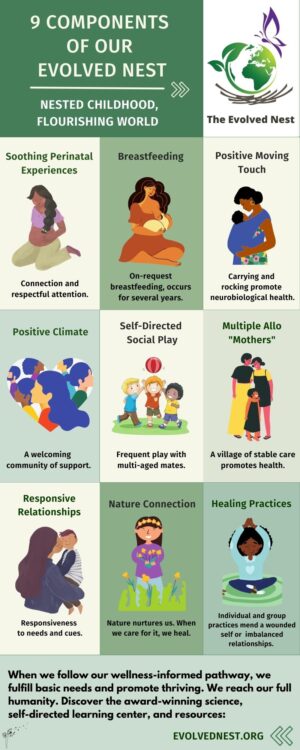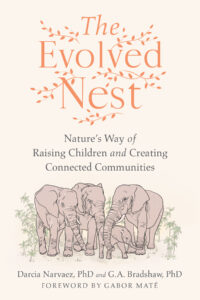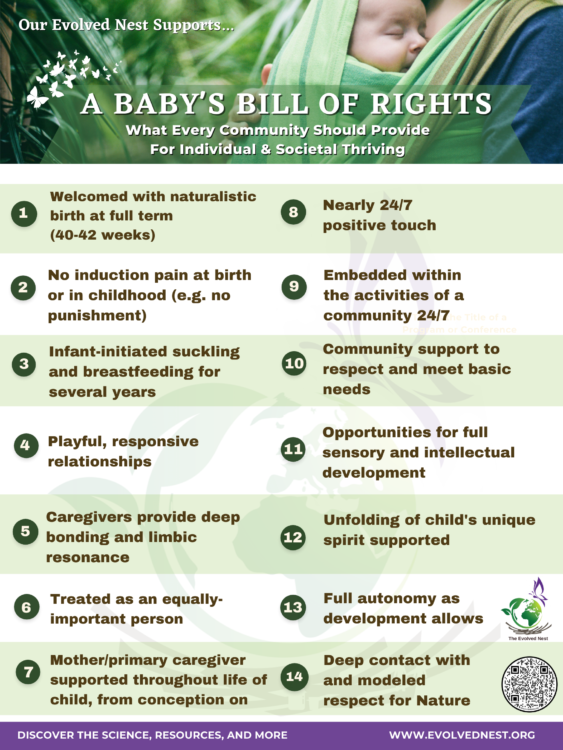Babies Are Not Machines
Parents are co-constructing a human being.

How do we grow a healthy organism? We provide the kind of environment that helps the entity thrive. Whether a Ficus house plant, a Doberman puppy, fermenting homemade beer, the environment must provide what the organism has evolved to expect—if it is going to turn out well. We accept the basic needs of plant, puppy, and beer and we humble ourselves to those needs. Babies deserve the same; babies are not machines.
Chances are that you, like me, spent most of your schooling immersed in one particular mode of consciousness: the analytic, linear, logical way of looking at the world that breaks reality into bits and pieces.* This mode is useful for creating order and enables control of the world in one way or another. It represents the way scholars, governments and businesses tend to split up and account for the world (because it is easier to measure bits).
This mode is not much use for raising children and in fact can do much harm. Alive with movement and connection, the living world depends on the interactions among entities. Health and wellbeing are in the relationships, the responsive back and forth of living together. This is true for parents/caregivers and babies.
A baby is more like a river, a windstorm, or a volcanic eruption—baby just flows. Every cell is flowing, blood is flowing, communications among systems are flowing—constantly. Approximately 37.2 trillion cells in baby’s body are each performing millions of complex reactions every second. They just need our cooperation. Our role is to provide the supports that keep the flows going, restoring the flow when baby gets stuck in distress. But we also need to learn to stay out of the way of the unfolding creation of a child’s unique spirit and beauty.
Distressing a baby slows, stops, or misdirects their flows.
Yet, all around us people talk about and even treat babies like they are largely static entities, not made of growing flowing life. Every day I hear or see advice to leave baby untouched (‘Don’t pick up the baby, you’ll spoil it’), admonitions to leave babies to cry (‘They have to learn independence’). These advisers, from authors to family members, ignore the living beingness that is under construction.
The view of the world/people as machines is presumed to have started with Rene Descartes’ elevation of mind over body (“I think, therefore I am” instead of “I feel/I relate/I love, therefore I am”). He elevated the analytical view of the world, governed by the left brain which dismisses the complexity of living things and treats anything other than its ideas, such as bodies and Nature, as inferior and suspect. Descartes was so divorced from livingness that he practiced vivisection on live animals, saying that their screams were just reflexes, not feelings; this view even spawned vivisection parties (Merchant, 1983).
Until recently, medical professionals assumed that babies had no feelings, performing circumcision on newborns without anesthesia or topical numbing (which often does not work), dismissing infant screams as reflexes. Most people are not so mindless as this anymore, but there is still a remarkable callousness towards the needs of babies.
Mechanistic thinking invaded parenting advice when psychology was trying to be a science (Watson, 1928) and it has never been exorcised. Too many parent advisers still advise treating babies as machines.
Here is what I mean.
 Parenting baby-as-machine means expecting to have clear boundaries—the parents have their life and babies have theirs. Parenting baby-as-machine means expecting to have to deal with feeding, changing diapers, and sheltering, but as one would do with a machine. The parent expects to get necessary tasks done and then to go on their way, even to go back to a pre-baby lifestyle.
Parenting baby-as-machine means expecting to have clear boundaries—the parents have their life and babies have theirs. Parenting baby-as-machine means expecting to have to deal with feeding, changing diapers, and sheltering, but as one would do with a machine. The parent expects to get necessary tasks done and then to go on their way, even to go back to a pre-baby lifestyle.
Parenting baby-as-machine means expecting to be able to shut down baby when preferred, that baby will follow parents’ wishes when they have them, that baby will turn off when the parent wills it so, like going to sleep on demand. In fact, babies are expected to put themselves to sleep, as parents watch from afar on a baby monitor. Babies are expected to learn independence from parents!
Parenting baby-as-machine can mean orienting to a premade set of instructions from “experts.” It can mean expecting someone to explain how to assemble the perfect baby, an instruction manual that indicates how different baby functions are activated by particular parent actions. ‘If you feed on a schedule, baby will learn to be orderly.’ ‘Baby will learn to sleep alone if you don’t pick them up when they fuss.’ Easy troubleshooting fixes are offered. ‘Put on some white noise to comfort baby in the crib alone.’ It means expecting to follow an outside set of rules and procedures, instead of orienting to babies’ needs, like forcing scheduled feedings and not expecting changes in feeding patterns day by day. After all, adults are in charge—they have the manual!
Parenting baby-as-machine means not following the signals of the baby but following someone else’s ideas of how babies should be treated and how they should act.
So it is a shock when the baby-as-machine does not behave. Parents might get frustrated and blame the baby. Baby is not following the plan! Or, parents will feel ashamed, for example, that their baby does not sleep through the night alone (but not one of us does!). Hopefully, parents awaken to the realization that there is no machine here, instead that baby wants to be in relationship, physically close, 24/7. And maybe the parent will realize that some parent advisers are pressuring parents to act like machines toward their child.
How can we verify that we are not machines? For one, we can’t be turned on and off. We grow and change and develop. I’m a different person than I was five years ago, aren’t you? Babies are growing so fast, we can see changes every five minutes (Brazelton & Nugent, 1995).
A few other things are different between a baby and a machine. See the Table comparing machines and babies. There is no off switch for a living baby. Babies’ parts cannot be treated in isolation. Babies have no static parts. Their parts added together do not make a whole—the whole is more than the sum of parts. Babies are dynamic living organisms and all parts work together in complex ways.
Table comparing machines and babies.
| MACHINES | BABIES |
| Machines are constructed from a set of human-made instructions. | Babies have internal processes that guide development in response to experience. |
| Machines can be turned on or off. | There is no off switch for a living baby. |
| Machines are built from static parts. | Top-down processes guide bottom-up processes |
| Machines are fixed, they don’t grow and develop. | Babies are becomings at every level, flowing, following a maturational schedule, aiming for optimal functioning. |
| Machines might be complicated but they are not complex. | Babies are complex systems: networks of networks of billions of ongoing actions. |
| Machines can be taken apart and put back together and still work. | Babies have no static parts. Their parts do not make a whole. |
| A machine’s relations have to be set up by the creators. | Incredible, immeasurable interactions are ongoing in baby’s body at every level of analysis. |
| Relations among parts are linear, logical. | Relations among processes are non-linear and contextually influenced. |
| Machines, even complicated ones, follow rules and procedures | A complex system has feedback loops, feedforward loops, gateway triggers governed by other gateway processes, etc. |
| Machines provide measurable outputs. | What is vital about babies is mostly immeasurable. |
| Machines are brittle, they cannot repair themselves, unless it is built in by the engineer. | Living organisms self-organize, self-monitor, self-repair. |
| Machines have clear boundaries. | Living organisms overlap with other living organisms and the rest of the natural world; boundaries are unclear |
Babies have internal processes that guide development in response to experience. Top-down processes guide bottom-up processes. At every level, babies are becomings. They are flowing toward fullness, following a maturational schedule that aims for optimal functioning. Babies are complex systems: networks of networks of billions of ongoing actions. Incredible, immeasurable interactions are ongoing in baby’s body at every level of analysis: relations among processes are non-linear and contextually influenced, and as a complex system there are feedback loops, feedforward loops, gateway triggers governed by other gateway processes. What is vital about babies is mostly immeasurable.
What is astounding is that babies are self-organizing personality, multiple biological and psychological processes, and coordinations within and among numerous systems according to the experiences they have with you and other carers.
Parents are co-constructing a human being.
The evolved nest includes the experiences babies expect in order to grow optimally. Babies have inner compasses guiding growth and development. So, nested parenting means learning to attend to baby’s signals and to respond with nested support. Baby will flow into a lifetime of cooperation, happiness and health.
Bibliography
Brazelton, T. B., & Nugent, J.K. (1995). The Neonatal Behavioural Assessment Scale, 3 rd edition.
MacKeith Press, London.
Descartes, R. (1637/1999). Discourse on method and meditations on first philosophy (D.A.
Cress, transl.). New York: Hackett Group.
Goldman, R. (1997). Circumcision, The hidden trauma: How an american cultural practice
affects infants and ultimately us all. New York: Vanguard
Lanius, R. A., Vermetten, E., & Pain, C. (2010). The impact of early life trauma on health and
disease: The hidden epidemic. New York, NY: Cambridge University Press.
Leo, P. (2007). Connection parenting, Parenting through connection instead of coercion, 2 nd ed..
Deadwood: OR: Wyatt-MacKenzie Publishing.
McGilchrist, I. (2009). The master and his emissary: The divided brain and the making of the
western world. New Haven, CT: Yale University Press.
McGilchrist, I. (2021). The matter with things: Our brains, our delusions, and the unmaking of
the world (vol. I and II). London: Perspectiva Press.
Merchant, C. (1983). The death of nature: Women, ecology and the scientific revolution. New
York, NY: Harper & Row.
Scott, J. C. (2009). The art of not being governed: An anarchist history of upland southeast
Asia. Yale University Press.
Schore, A.N. (2019). The development of the unconscious mind. New York: W.W. Norton.
Watson, J. B. (1928). Psychological care of infant and child. New York: W. W. Norton & Co.
* This way of viewing the world, from the intellectual perch alone, as an onlooker to life, is
associated with autism and schizophrenia where people get stuck as spectators of life and cannot
escape (McGilchrist, 2021). The rest of us can get out by being careful what kind of attention
and which mode of consciousness we bring to situations.



